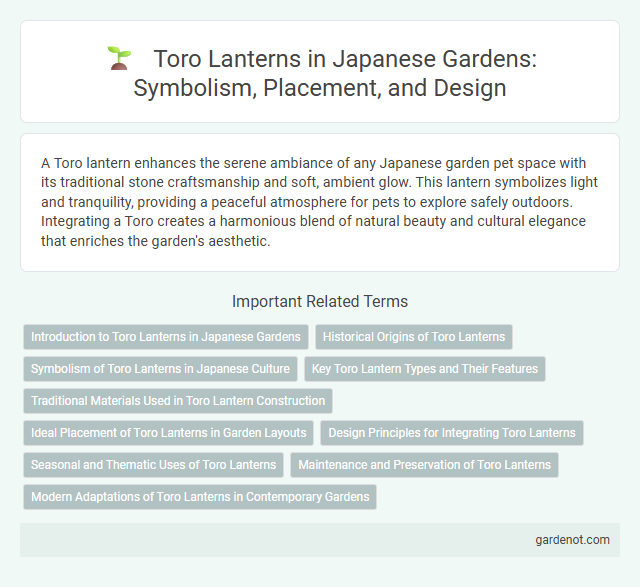A Toro lantern enhances the serene ambiance of any Japanese garden pet space with its traditional stone craftsmanship and soft, ambient glow. This lantern symbolizes light and tranquility, providing a peaceful atmosphere for pets to explore safely outdoors. Integrating a Toro creates a harmonious blend of natural beauty and cultural elegance that enriches the garden's aesthetic.
Introduction to Toro Lanterns in Japanese Gardens
Toro lanterns are traditional Japanese stone or metal lanterns commonly found in Japanese gardens, symbolizing light and spirituality. These lanterns originated during the Nara period and are designed with a base, shaft, lightbox, and roof, often intricately carved to blend harmoniously with natural surroundings. Toro lanterns enhance the garden's aesthetic while providing subtle illumination, reflecting the principles of wabi-sabi and tranquility in Japanese garden design.
Historical Origins of Toro Lanterns
Toro lanterns originated in ancient Japan during the Asuka period (538-710 AD), where they were initially used in Buddhist temples to symbolize enlightenment. These stone or metal lanterns became prominent features in Japanese gardens by the Heian period (794-1185 AD), blending spiritual and aesthetic elements. Their design reflects traditional craftsmanship and cultural symbolism, illuminating paths while preserving historical heritage.
Symbolism of Toro Lanterns in Japanese Culture
Toro lanterns in Japanese gardens symbolize spiritual illumination and protection, traditionally guiding spirits and pilgrims along sacred paths. These stone lanterns embody harmony, tranquility, and the connection between the physical and spiritual worlds, reflecting the principles of Shinto and Buddhism. Their soft, glowing light enhances the garden's meditative atmosphere, reinforcing themes of enlightenment and balance in Japanese culture.
Key Toro Lantern Types and Their Features
Toro lanterns in Japanese gardens come primarily in two key types: the pedestal (tachi-gata) and the snow-viewing (yukimi-gata). The pedestal type stands tall with a sturdy base and intricately carved stone, providing vertical elegance and lasting durability. The snow-viewing type features a wide, flat roof designed to hold snow, creating a serene winter aesthetic while softly illuminating pathways.
Traditional Materials Used in Toro Lantern Construction
Toro lanterns in Japanese gardens are traditionally crafted from natural materials such as granite, bronze, and wood, ensuring durability and a harmonious aesthetic. Granite Toro provides a robust, weather-resistant option, while bronze offers intricate detailing and longevity with a patina that enhances over time. Wood Toro, often made from cedar or cypress, lends warmth and rustic charm, though it requires careful maintenance to withstand outdoor conditions.
Ideal Placement of Toro Lanterns in Garden Layouts
Ideal placement of Toro lanterns in Japanese garden layouts emphasizes harmony with natural elements such as water features, pathways, and stone arrangements. Positioning Toro lanterns near pond edges or along winding garden paths enhances aesthetic appeal while providing subtle illumination during evening hours. Careful integration ensures the lanterns complement the overall landscape design, evoking tranquility and traditional ambiance.
Design Principles for Integrating Toro Lanterns
Toro lanterns in Japanese gardens embody the principles of balance, simplicity, and natural harmony, serving as both functional light sources and aesthetic focal points. Their placement follows the concept of shakkei, or "borrowed scenery," seamlessly integrating with surrounding plants, water features, and pathways to enhance the garden's overall composition. Crafted from stone or metal, Toro lanterns use subtle textures and traditional forms to complement the tranquil atmosphere and evoke a sense of timelessness within the garden space.
Seasonal and Thematic Uses of Toro Lanterns
Toro lanterns in Japanese gardens enhance seasonal ambiance by illuminating cherry blossoms in spring and maple leaves in autumn with a warm, inviting glow. These stone or metal lanterns serve thematic purposes during festivals like Obon, symbolizing guiding spirits and adding cultural depth. Their placement strategically highlights garden features, creating a serene atmosphere aligned with the changing seasons and traditional celebrations.
Maintenance and Preservation of Toro Lanterns
Toro lanterns require regular cleaning to prevent moss and lichen buildup that can erode the stone. Preservation efforts involve careful repairs using traditional materials and techniques to maintain historical authenticity. Proper placement and protection from harsh weather conditions extend the longevity of these iconic Japanese garden features.
Modern Adaptations of Toro Lanterns in Contemporary Gardens
Modern adaptations of Toro lanterns in contemporary Japanese gardens integrate traditional stone craftsmanship with innovative materials such as weather-resistant metals and LEDs for enhanced durability and illumination. These redesigned lanterns maintain the cultural symbolism of tranquility and light while offering energy efficiency and customizable lighting options that complement minimalist landscape designs. Incorporating Toro lanterns with smart technology and solar power further aligns them with sustainable gardening practices and modern aesthetic preferences.
Toro Infographic

 gardenot.com
gardenot.com